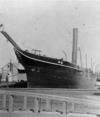
|
USS Huron
 Bladen Street beach, Nags Head, NC Bladen Street beach, Nags Head, NC
|
Max Depth: 26-30ft/8-9m
Average Viz: 5-10ft/2-3m
Entry Type: Shore
Bottom Composition: Sand
Aquatic Life: Might See Something
|
Spring: 56-60°F/13-16°C
Summer: 71-75°F/22-24°C
Fall: 56-60°F/13-16°C
Winter: 50-55°F/10-13°C
|
|



|
|
USS Huron is a shore accessible salt water dive site, located at Bladen Street beach, Nags Head, NC. The maximum depth is 26-30ft/8-9m. The average visibility is 5-10ft/2-3m.
More info
shorediving.com/Earth/USA_East/North_Carolina/USS_Huron/index.htmNags Head between mileposts 11 and 12. The Huron is 250 yards off Bladen Street beach, and the tugboat Expolorer is to the left of the Nags Head Fishing pier.
The USS Huron
Built a decade after the Civil War, the USS Huron was constructed during a period of transition between the old and new navy. The Huron and her two sister ships were the last American naval vessels to be built of iron rather than steel and to be equipped with sails to supplement their steam engines. During her brief career (1875-1877), the Huron visited ports in Mexico, Venezuela, Columbia, Key West, Mobile, Charleston, Norfolk, Boston, New York, and Washington, D.C. However, it was the tragedy of the Huron’s sinking on November 24, 1877, that brought the ship to national attention.
Specifications:
Built: Chester, Pennsylvania, 1875
Length: 175 feet
Beam: 32 feet
Draft: 13 feet
Crew: 16 officers, 118 enlisted men
Power: A compound steam engine with five coal-burning boilers and a 12-foot-diameter propeller. The Huron also had three masts equipped with sails.
11-inch Dahlgren smoothbore cannon(1)
9-inch Dahlgren smoothbore cannon (2)
60-pounder Parrot rifle (1)
12-pounder Dahlgren boat howitzer (1)
50-caliber Gatling gun (1)
The Loss of the USS Huron
The Huron left Hampton Roads, Virginia, on Friday, November 23, 1877. She was headed for Havana, Cuba, to survey the surrounding coast. On her first night out to sea, the ship encountered a heavy storm blowing from the southeast. The storm combined with a small error in the ship’s compass to cause the Huron to run aground off Nags Head at 1:30 a.m., November 24, 1877. Even though the Huron was only 200 yards from the beach, the heavy surf, strong currents, and cold temperature prevented most of the crew members from attempting the swim to shore. Most of the crew tried to remain on the ship in the hope that help would arrive. However, no one came to the aid of the sailors: lifesaving stations had been closed until December. The elements eventually took their toll on the storm battered men. Many lost their strength and were washed overboard by waves. One huge wave swept at least twelve sailors away at one time. In all, ninety-eight men lost their lives during the night. The federal government was severely criticized for its failure to provide adequate funding for the United States Lifesaving Service. Two months after the wreck of the Huron, the steamship Metropolis ran aground twenty-three miles to the north, with the loss of eighty-five lives. These two disasters prompted Congress to appropriate funding to build additional lifesaving stations along the North Carolina coast and increase their months of operation.
The USS Huron Today
The Huron site is located approximately 250 yards from the beach. During the summer months, buoys mark the bow and stern of the wreck. Divers and snorkelers who visit the site can see a wide variety of sea life as they swim over the remains of the historic warship. Many portions of the wreck hold points of interest such as boilers, cannonball storage racks, and the huge propeller and rudder.